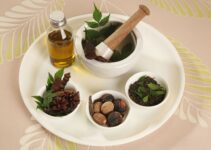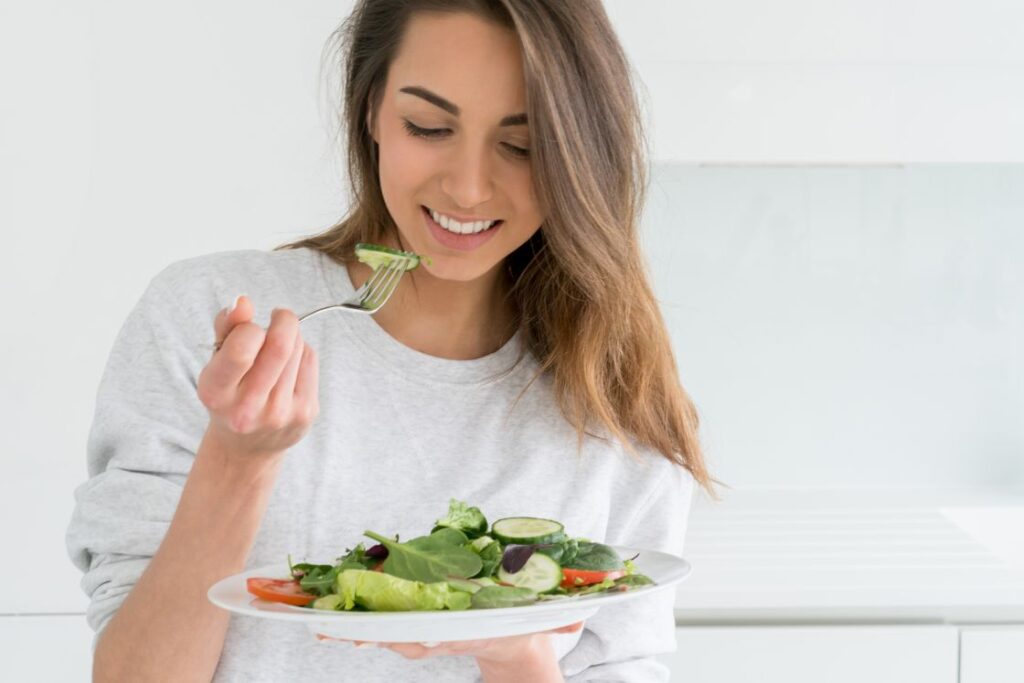
Ayurveda recommends that the vata dosha should be kept in balance at all times as the functioning of the pitta and kapha dosha largely depends on it.
There is a likelihood that you are a Vata body type if you are afflicted with issues like dry skin, constipation, disturbed sleep, lightheadedness, weight loss, and diminished strength.
Healthy digestion is viewed in Ayurveda as the cornerstone of good health. It advises consuming meals that harmonize the predominant dosha.
One of the best things you can do if you’ve been informed you should concentrate on balancing Vata dosha is to work on your diet. To balance Vata dosha, Ayurveda recommends Vata pacifying diet that emphasizes warm, nourishing, and grounding foods, and avoids cold, raw, and light foods that can increase Vata symptoms.
Vata meals help healthy digestion and elimination while feeding and lubricating the tissues, keeping the moisture, and maintaining warmth to calm the Vata. By following a balanced Vata diet, you can enjoy better digestion, a stable mood, and balanced body weight, among other benefits.
This article will provide an overview of the Vata diet, including what foods to take to balance Vata dosha and what to avoid. We have listed some suggested meal options and a list of vegetables, fruits, spices, oils, etc that you should include and avoid in your diet to balance Vata dosha. Whether you are a Vata individual or just curious about Ayurvedic nutrition, this article will help you understand the principles of the Vata diet and how to apply them in your daily life.
How to Balance Vata Dosha with Your Diet
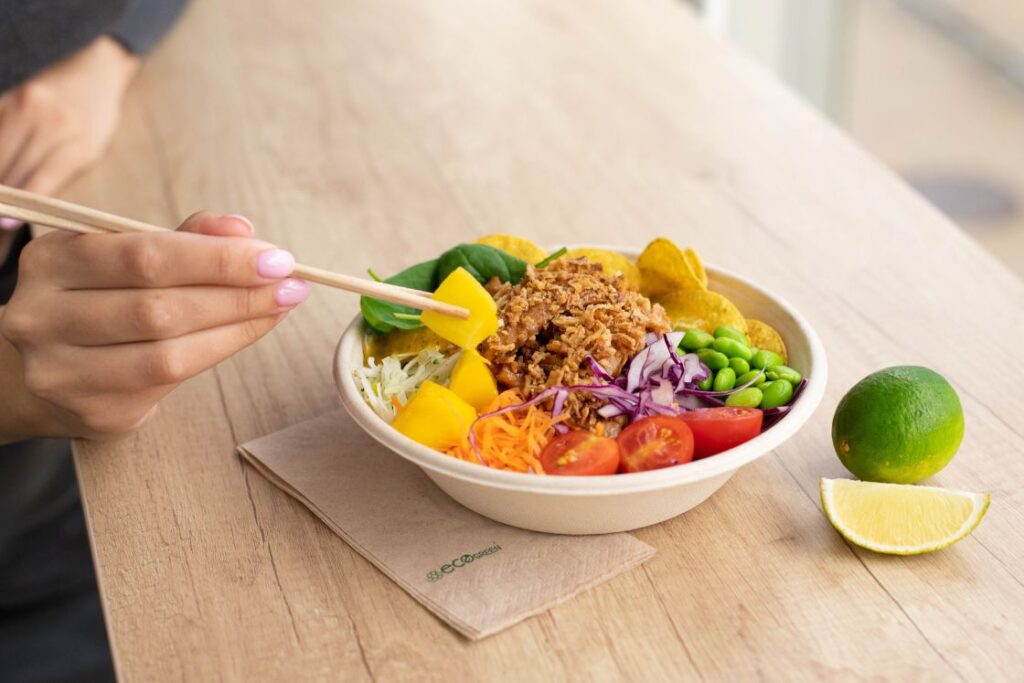
The general idea behind creating a Vata diet is following the principle of opposites for reducing high Vata levels. Choose food items which have counter properties to normal Vata qualities. For example, to counteract the dryness quality of Vata, incorporate liquid or unctuous foods in your diet regularly.
Similarly, include a variety of “heavy” meals in your diet to provide substance and sustained nourishment. Foods with a smooth texture to counteract roughness, and warm or hot foods to counterbalance the cooling character of Vata.
To assist you to start appreciating which foods perform effectively to balance Vata dosha, the following tips should be followed:
1. Favor warm and cooked food over cold and raw foods
It cannot be emphasized enough that vata people should always consume warm cooked meals. Since Vata is cold naturally, having warm and hot food and drinks is best to keep Vata in balance.
The cold quality of Vata is also one of the main reasons for irregular digestion, which can be easily countered by having home-cooked meals regularly. They will not only energize you from the inside out but also support your digestive system.
If your Vata is out of balance, avoid raw food, leftover, and frozen food, carbonated drinks, and food kept in the fridge because it has generally cooling energy dominant and coldness creates vata imbalance. Make sure whatever you are consuming, be it a beverage, salad, or meal, the ingredients should be mostly fresh and cooked properly.
2. Indulge in oily and moist foods
Another significant quality of Vata is its dryness. This dryness manifests in the form of dry skin, brittle nails and hair, and less lubrication of the joints. It can be offset by incorporating various oils such as almond oil, sunflower oils, avocado oil, etc, and ghee. These oils will bring significant hydration to the body.
Furthermore, hydrating foods like soups and stews, as well as wet foods like berries, melons, summer squash, zucchini, and yogurt, serve to counteract the dry nature of Vata. Foods high in fat, such as avocado, coconut, olives, buttermilk, cheese, eggs, milk, wheat, nuts, and seeds, are advantageous as well.
It is highly advised that you stay away from consumables that enhance dryness such as popcorn, white potato, dried fruits, crackers, etc.
3. Favor sweet, sour, and salty flavours over pungent, bitter, and astringent
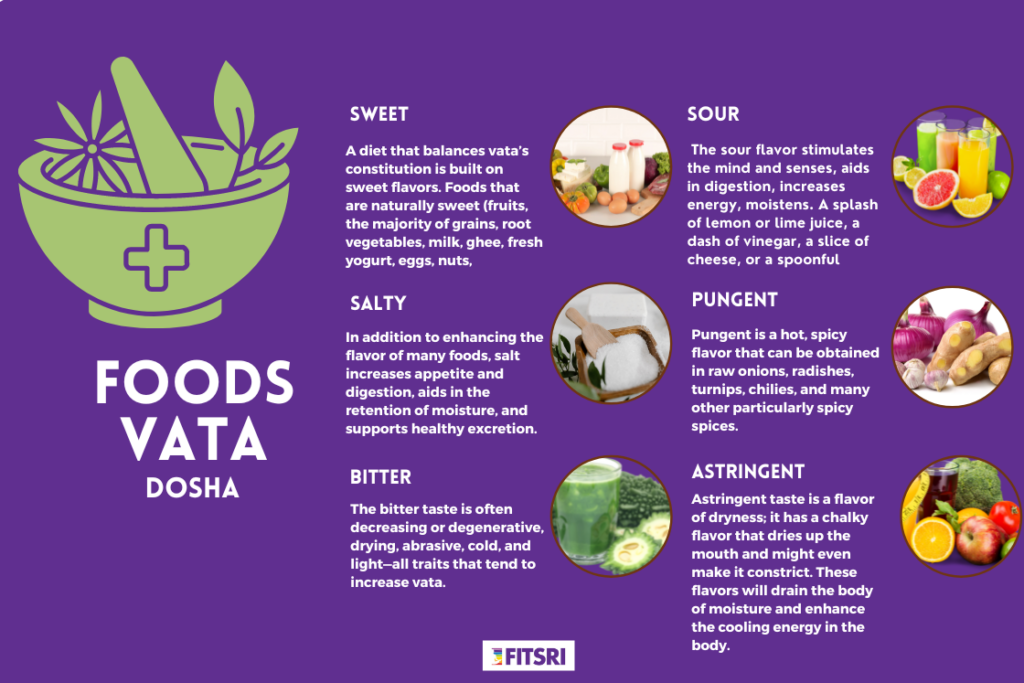
The 3 ayurvedic tastes – sweet, sour, salty – should always be kept in mind when making meals for Vata body type. These flavours provide moisturizing, oily, hot, warm, heavy, nourishing, soft, and grounding qualities at the same time.
Sweet – A diet that balances vata dosha is built on sweet flavours. In addition to being the primary source of sustenance for Vata, sweet also dominates the taste of the majority of Vata foods. Foods that are naturally sweet (fruits, the majority of grains, root vegetables, milk, ghee, fresh yogurt, eggs, nuts, seeds, oils, lean meats) are typically nourishing, grounding, strengthening, and gratifying; thus good to balance Vata dosha.
Sour – The sour flavour stimulates the mind and senses, aids in digestion, increases energy, moistens other foods, and aids in the elimination of extra wind (think gas and bloating); hence works for the Vata diet. A meal’s sour flavour usually serves to enhance and balance other flavours rather than serving as the main attraction. A splash of lemon or lime juice, a dash of vinegar, a slice of cheese, or a spoonful of sour cream are all good examples of sour additives.
Salty – In addition to enhancing the flavor of many foods, salt increases appetite and digestion, aids in the retention of moisture, and supports healthy excretion. Although choosing the salty flavor does not indicate that your food should taste pickled, the salty flavour is almost fully obtained from salt itself. It is often adequate to simply be aware of adding savoury ingredients and making sure that your diet contains salt.
A combination of sweet, sour and salty flavours can easily counter the cold, light, dry, clear, and rough energies of vata. They are also helpful in calming down excess energy, improving digestive fire, nourishing the tissues, and providing muscle strength.
On the contrary, you should fully avoid pungent, astringent, and bitter flavours for Vata dosha as they will aggravate the energies mentioned above.
Pungent – Hot, dry, and light in flavor, the pungent taste is exceedingly drying to the body and accentuates the rough texture. Pungent is a hot, spicy flavor that can be obtained in raw onions, radishes, turnips, chilies, and many other particularly spicy spices.
Bitter – The bitter taste is often decreasing or degenerative, drying, abrasive, cold, and light—all traits that tend to increase vata.
Astringent – Essentially, the astringent taste is a flavour of dryness; it has a chalky flavour that dries up the mouth and might even make it constrict. Along with some other fruits, vegetables, grains, and baked products like apples, cranberries, artichokes, broccoli, cauliflower, lettuce, and rice cakes, legumes are typically astringent in flavour.
These flavors will drain the body of moisture and enhance the cooling energy in the body.
However, the sweet, sour, and salty flavors should be taken in moderation to avoid the increase of fire, water, and earth elements.
4. Select foods with nourishing, grounding, and stabilizing qualities
Although the heavy aspect is the real opposite of vata’s lightness, excessively heavy, dense foods can readily strain Vata’s sensitive digestive system. Typically, it is healthier to think of nourishing food as a way to ground the lightness of Vata, as well as consume meals that provide the body with substantial nourishment.
You might find these qualities in sweet foods root vegetables, fruits, nuts, and milk. This is also another reason, eating sweet food is highly encouraged for Vata body type.
Canned food, prepared meals, and pastries are examples of highly processed foods that tend to be fairly heavy, lack of prana (vital life-force energy), and often aggravate Vata.
Furthermore, as they contribute to weakening Vata’s requirement for grounded stability, stimulants like caffeine, nicotine, and hard alcohol should be limited or avoided.
5. Use spices and sweeteners that are favourable for Vata constitutions
Spices are crucial for optimum digestion because they aid to stoke the digestive fire (Agni) and get the gastrointestinal tract ready for food intake, absorption, and assimilation. So, in addition to being used in meals and snacks, spices should be used as a digestive aid.
The majority of spices are great for Vata, given that none of your recipes is too spicy (due to excessive use of cayenne pepper, chilli peppers, and the like).
The majority of sweeteners are beneficial for Vata, however, it’s usually advisable to stay away from large amounts of refined sugar. Choose natural sweeteners over those that have been heavily processed. In particular, warming sweeteners like honey, jaggery, and molasses are beneficial in balancing Vata’s propensity for coldness.
6. Choose foods that are less fibrous and have a smooth texture
The fibre content of raw fruits and vegetables yields them a bit of a rough quality, which is why they are frequently referred to as “roughage.” Foods like broccoli, cabbage, cauliflower, dark leafy greens, and many beans are incredibly rough even when cooked, so it may be better to limit them while you are attempting to calm your Vata.
If you do consume them, make sure to cook them thoroughly, add plenty of butter, oil, or ghee to the dish, and season with Vata-balancing herbs and spices.
The roughness of Vata, on the other hand, can be greatly reduced by consuming smooth-textured meals and preparations, such as bananas, rice pudding, hot cereal, hot spiced milk, root vegetables, and puréed soups.
Foods to balance Vata Dosha
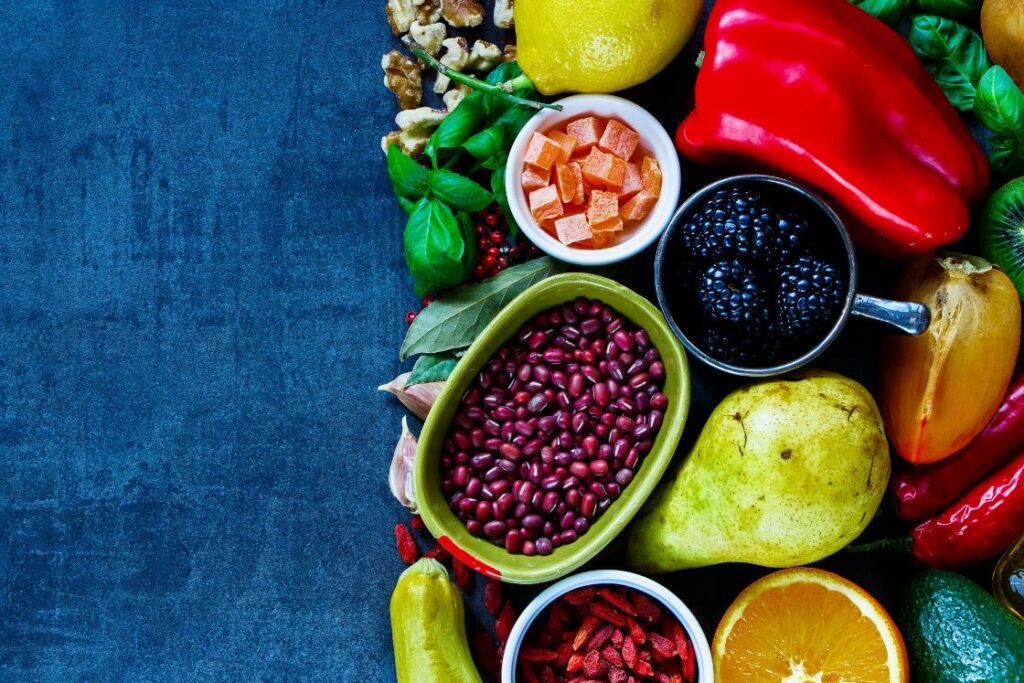
A Vata dosha diet can include a variety of food options including vegetables, fruits, oils, grains, spices, sweeteners, nuts, etc.
Here’s a wholesome Vata diet which includes a list of foods to keep your body’s Vata levels in balance:
- Whole grains: Rice, oats, barley, quinoa, and millet
- Starchy vegetables: Sweet potatoes, potatoes, carrots, beets, winter squashes, and peas
- Nuts and seeds: Almonds, cashews, pumpkin seeds, sunflower seeds, and sesame seeds
- Legumes: Lentils, mung beans, chickpeas, and black-eyed peas
- Dairy: Milk, ghee, butter, cheese, and yogurt
- Oils: Olive oil, coconut oil, and ghee
- Fruits: Bananas, mangos, pineapples, and oranges
- Spices: Ginger, cinnamon, cardamom, cumin, and fennel
- Sweeteners: Raw honey, maple syrup, and dates
Below we have prepared lists of different food items individuals can take to balance Vata dosha.
Vegetables for Vata diet
When creating a Vata-pacifying diet, it’s best to focus on warm, grounding, and nourishing vegetables. Vegetables that are greeny, leafy, naturally sweet & filling and warm and cooked, such as roasted or steamed, are grounding for Vata and can help balance Vata’s light and dry nature.
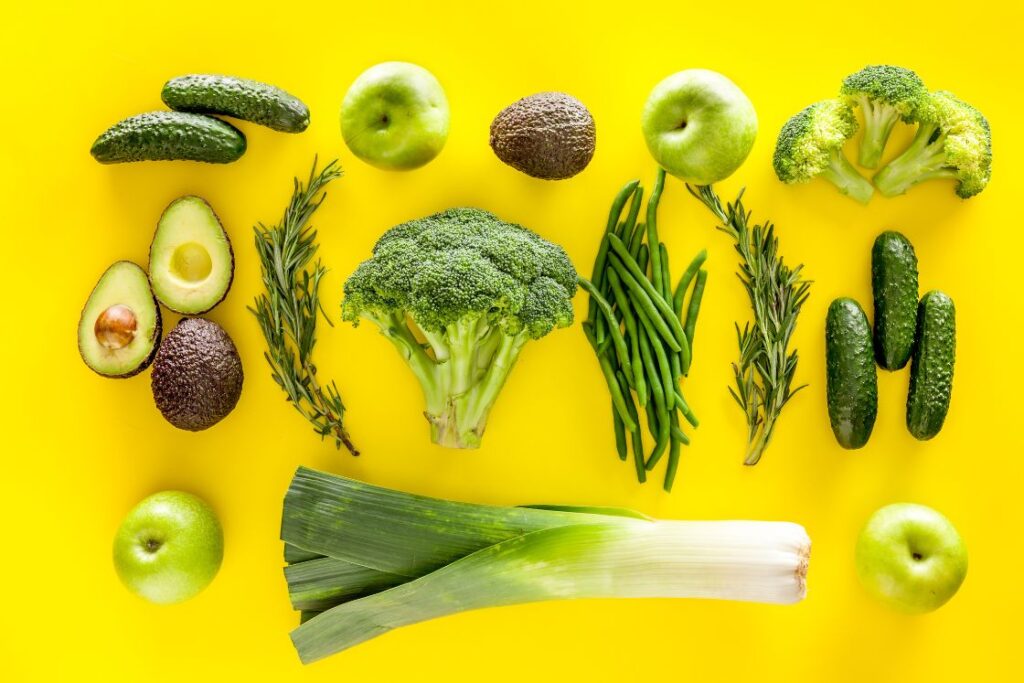
Here is a list of vegetables that are beneficial for balancing Vata:
- Root vegetables: Carrots, beets, yams, and sweet potatoes, are grounding for Vata and provide a source of healthy carbohydrates.
- Leafy greens: Spinach, collard greens, and other leafy greens are nourishing for Vata and provide a source of vitamins and minerals.
- Squashes: Butternut, acorn, and other squashes are warm, grounding, and nourishing for Vata, and provide a source of healthy carbohydrates and fiber.
- Cruciferous vegetables: Cabbage, cauliflower, and other cruciferous vegetables are grounding for Vata, but they are best eaten cooked rather than raw.
- Asparagus: Asparagus is a grounding vegetable that is rich in vitamins and minerals, and helps to balance Vata.
- Peas: Cooked Peas are a warm and grounding vegetable that is high in protein and fiber, and can help to balance Vata.
Vegetables to avoid
Make sure to not eat any kind of raw foods as they will contribute to the cool characteristic of vata dosha. Additionally avoid dry, rough, and cold vegetables.
Some vegetables to avoid are as follows:
- Artichokes
- Broccoli
- Brussels Sprouts
- Raw Carrots
- Dandelion Greens
- Kale
- Mushrooms
- Raw Onion
- Hot Peppers
- White Potatoes
- Raw Cauliflower and Cabbage
- Raw Tomatoes
- Zucchini
Fruits for Vata diet
Sweet, ripe, and juicy fruits are typically the best for balancing Vata dosha. Since most fruits have the quality of sweetness, moisture, warmth, and fibrous, they balance the lightness, dryness, and erratic nature of Vata dosha.
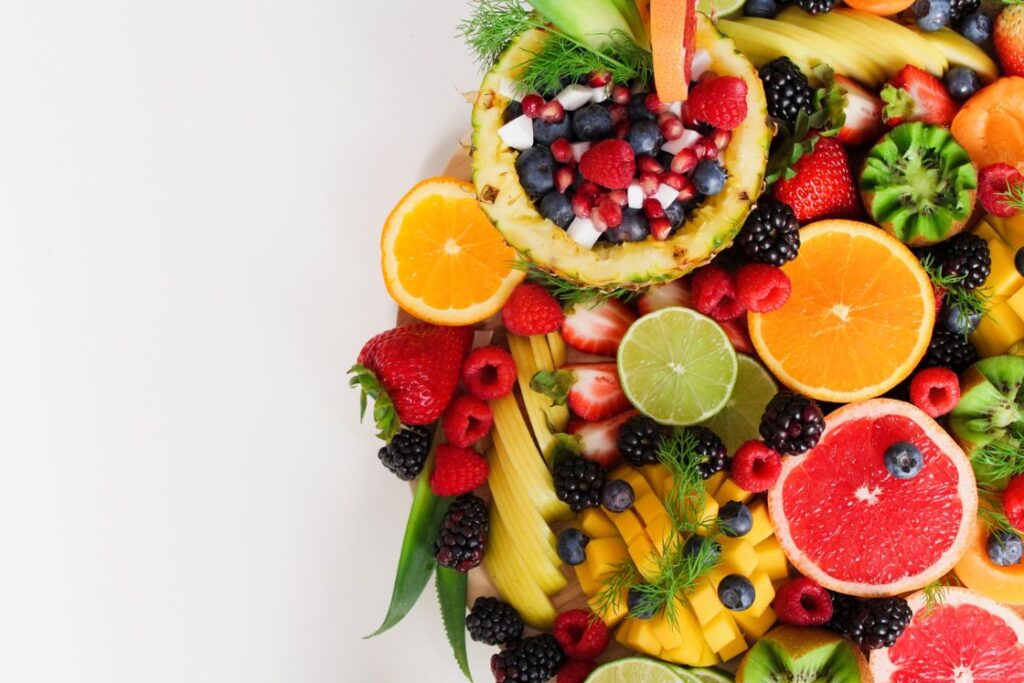
Here is a list of fruits that balances Vata dosha:
- Bananas
- Papaya
- Peaches
- Mangoes
- Papayas
- Strawberries
- Blueberries
- Raspberries
- Cherries
- Avocados
- Apples
- Pears
Fruits to avoid
Avoid fruit that is particularly cool, astringent, drying, or harsh, which contains mostly dried fruit when it has not been soaked or boiled to rehydrate it.
- Raw Apples
- Green Bananas
- Cranberries
- Watermelon
- Pears
- Persimmons
- Pomegranate
- All Dried Fruits
Legumes for Vata diet
Legumes that are light, easy to digest, and have a grounding and warming effect on the digestive system, are generally considered good for balancing Vata dosha.
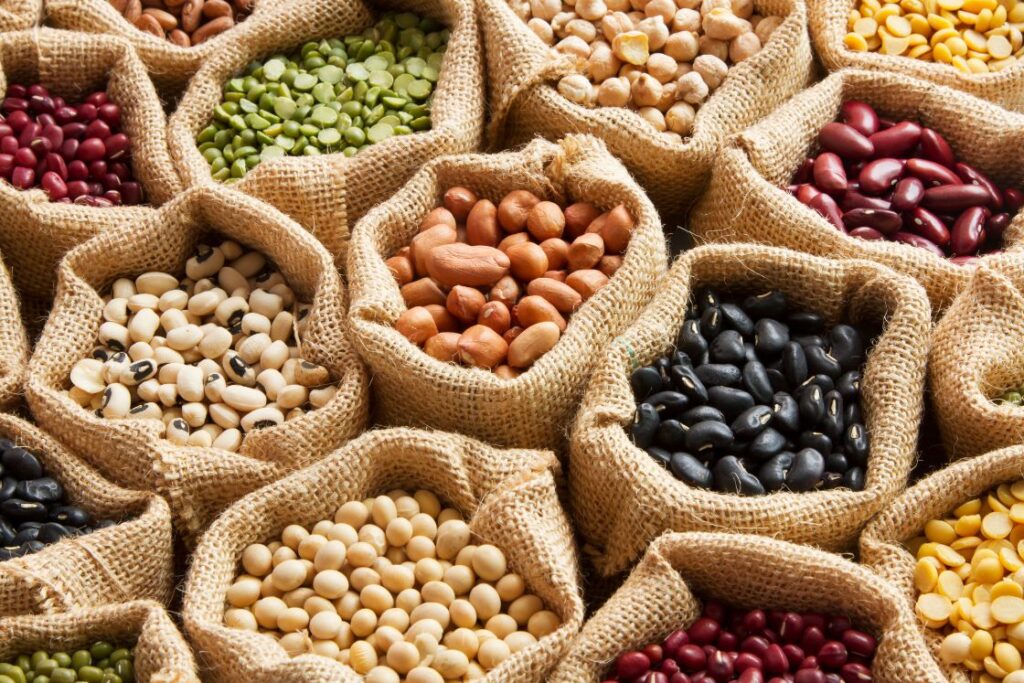
Here is a list of legumes for balancing Vata dosha:
- Mung beans
- Soy
- Lentils
- Chickpeas
- Lima beans
- Peas
- Tofu
- Adzuki beans
Legumes to avoid
Vata body types should typically avoid dry, hard, and rough legumes such as beans and peas as they are hard to digest and can lead to issues like bloating, flatulence, and gas.
Some such legumes to be avoided are:
- Adzuki Beans
- Black Beans
- Black-Eyed Peas
- Garbanzo Beans (Chickpeas)
- Kidney Beans
- Brown Lentils
- Lima Beans
- Navy Beans
- Pinto Beans
- Soy Beans, Flour, Powder
- Split Peas
- White Beans
Oils for Vata Diet
In general, since most oils have moisturizing qualities, including oils in your diet can help to hydrate and nourish the dry and brittle nature of Vata. Some oils, such as sesame and olive oil, are considered warming, which can help to balance the cold and dry nature of Vata.
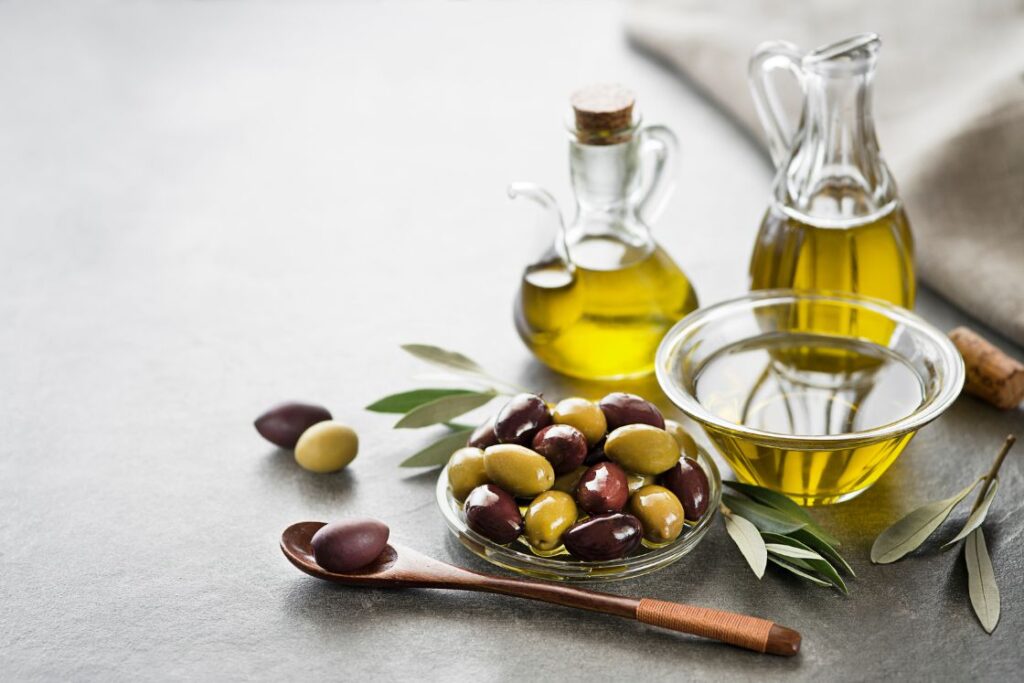
Some of the best Vata balancing oils are:
- Ghee
- Almond Oil
- Avocado Oil
- Castor Oil
- Mustard Oil
- Olive Oil
- Sesame Oil
Oils to avoid
Oils that are excessively light and dry, too complex to digest, or heavily processed are less suited to vata.
- Canola Oil
- Corn Oil
- Soy Oil
Grains for Vata Diet
The ideal grains for the vata dosha are those that are smooth, grounding, sweet, and effortlessly ingested. Smooth foods include mushy grains and puddings, both of which taste wonderful when sweetened and spiced.
Some of the best Vata balancing grains are:
- Durham Flour
- Amaranth
- Oats
- Quinoa
- Rice (all types)
- Couscous
- Wheat
- Polenta
Grains to avoid
On the contrary, grains that are difficult to cook or can be too drying for the body should be avoided. Moreover, extremely light, rough, dense, and heavy grains should not be a part of the diet.
- Barley
- Buckwheat
- Cereals (cold, dry, or puffed)
- Corn
- Crackers and Granola
- Millet
- Muesli
- Dry Oats and Oat Bran
- Rye
- Sago
- Tapioca
- Wheat Bran
Dairy products for Vata Diet
Dairy is advantageous for persons who are predominately vata or who are facing an imbalance in this dosha because it usually has sweet, weighty, and harmonious properties. The ideal dairy to eat for absorbing prana and aiding easy digestion is fresh, unprocessed, warm dairy.
To encourage proper digestion, it is ideal to have dairy warmed and spiced at least an hour before meals.
Some of the preferred dairy for vata are:
- Ghee
- Butter
- Buttermilk
- Ricotta, Cottage Cheese
- Cream Cheese
- Cow’s milk
- Goat’s Milk
- Almond Milk
- Oat Milk
Dairy to avoid
Hard cheeses, highly processed preparations, and cold dairy products are a big no-no for vata individuals as they will enhance the cold quality and might also clog the nadis.
Things to avoid are :
- Ice-cream
- Frozen yogurt
- Hard cheeses
- Powdered Milk
Meat products for Vata Diet
Meat is only advised when it is necessary for recuperation or if there are no alternative food options. When someone is extremely undernourished, frail, or recovering from illness, they may eat meat. Warming, sweet, hearty, and moist meats are the most effective for calming vata.
Favorable Meat options are:
- Goat
- Beef
- Chicken (especially dark)
- Duck
- Eggs
- Fish (fresh and salt water)
- Turkey (dark)
Meat products to avoid
On the contrary, meats that are too heavy and difficult to digest should not be a part of your diet. Some such meat products are:
- Lamb
- Mutton
- Pork
- Venison
- Rabbit
- Turkey (white)
Nuts & Seeds for Vata Diet
Seeds and nuts are excellent vata-pacifiers. They are rich in nutrients and provide a potent blend of proteins that is very advantageous to vata. Additionally, they are a rich source of good fats, which support and amplify the dry and light properties of vata dosha.
Some nuts and seeds that Vata individuals can include in their diet are:
- Almonds (Soaked and blanched)
- Cashews
- Hazelnuts
- Macadamia Nuts
- Peanuts
- Soaked Pecans and Walnuts
- Pine Nuts
- Pistachios
- Pumpkin Seeds
- Sesame Seeds
- Sunflower Seeds
- Chia Seeds
- Flax Seeds
Nuts and seeds to avoid
Because they are relatively weighty, nuts and seeds should only be consumed in moderation in order to avoid taxing the vata’s unpredictable digestive system.
Sweeteners for Vata Diet
Vata individuals should choose natural sweeteners over those that have been heavily processed. The use of natural sweeteners, which still have a sweet flavour but also include warming and moist properties that calm the vata dosha is advised.
Warming sweeteners, such as honey, jaggery, and molasses, are particularly effective at balancing vata’s propensity for coldness.
Recommended sweeteners for vata dosha are:
- Barley Malt
- Date Sugar
- Honey (raw)
- Jaggary
- Molasses
- Rice Syrup
- Sugarcane Juice
Sweeteners to avoid
In general, it’s recommended to stay away from big amounts of refined sugar. However, honey can be depleted if used excessively and is also extremely astringent.
- Artificial Sweeteners
- White Sugar
- Honey (heated or cooked)
- Fructose
Spices for Vata Diet
As they aid in igniting the digestive fire and prime the gastrointestinal tract for food intake, absorption, and digestion, spices are crucial for healthy digestion.
The majority of spices are great for vata, as long as you don’t use too much cayenne, chile, or other spicy spices in any of your foods.
Spices that are advised for vata doshas are:
- Ajwan
- Allspice
- Turmeric
- Cardamom
- Cinnamon
- Cloves
- Black Pepper
- Fennel
- Garlic
- Ginger
- Paprika
- Parsley
Spices to avoid
Spices that have astringent, pungent, bitter, and extremely hot should be completely avoided. Examples of spices that should be avoided.
- Chili Powder
- Neem Leaves
- Fenugreek
- Hing (Asafoetida)
- Cayenne Pepper
Recommended vata dosha meals
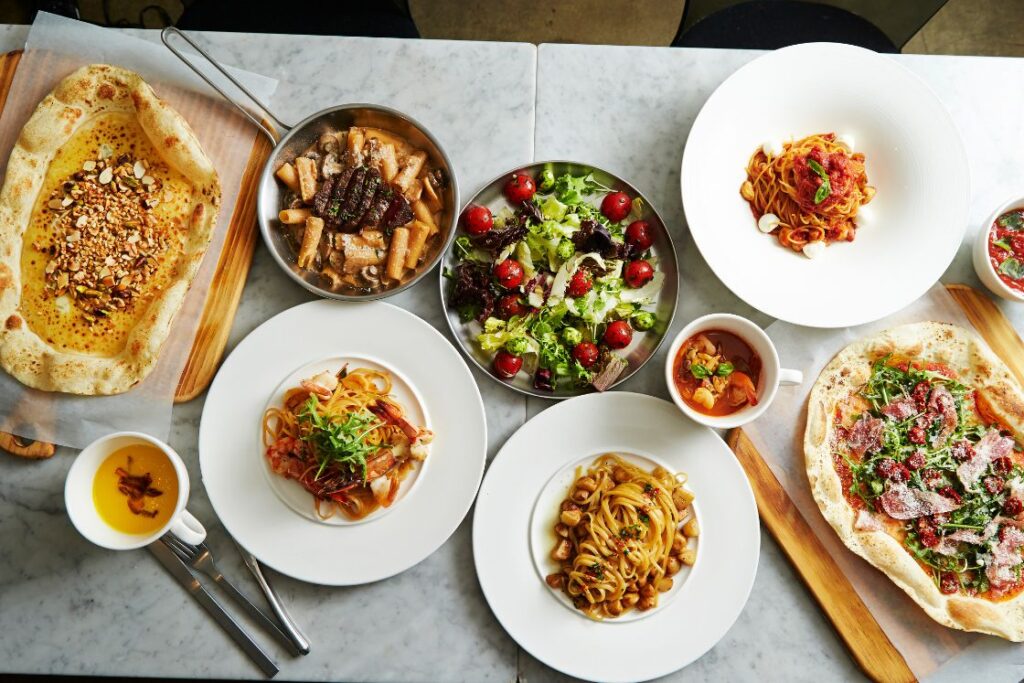
A Vata diet is just a blend of extremely nourishing and satisfying foods that will increase your hunger, help good digestion, support elimination, and nourish your body.
Vata is balanced by routine, therefore eating three complete meals each day (about at the same times each day) significantly balances aggravated vata and supports sensitive digestion.
Also, make sure to drink enough water throughout the day to keep yourself hydrated and nourished.
Here are some suggested meals that will calm your Vata throughout the day.
Breakfast
When Vata is increased, a full breakfast is typically quite balancing to the overall system, providing it is not too heavy for one’s digestive capabilities.
Below are some suggestions –
- Eggs, sauteed vegetables, and buttered toast with avocado. Cook them with butter, ghee, or any oil mentioned in the list above.
- Cereals in hot milk, porridge, oatmeal, and rice pudding for a rich breakfast. Include nuts and seeds to add different textures and tastes and garnish with ghee, honey, or maple syrup. Including spices like cinnamon, cardamom and ginger are also recommended.
- Milkshakes made with soaked dates, soaked and peeled almonds, ripe bananas cinnamon, cloves, and cardamom are a way to have a fulfilling breakfast.
Lunch
Lunchtime is one of the most important meals of the day and you should have a hearty and nourishing meal to satisfy the vata energies.
Have a look at the below suggestions:
- Salads are one of the best options to crave your mid-day hunger. Use vegetables, nuts, and soaked and cooked grains of your choice, and finish them with a drizzle of lemon, olive oil, and basil dressing.
- You could also go for a steamed fish with a side of mashed sweet potato, some rosemary, lime, and basmati rice.
- For an Indian touch, make a big bowl of khichdi – rice mixed with urad or toor dal and cooked in ghee until semi-solid. Don’t forget to add salt, and whole spices such as clove, cardamom, and turmeric.
- Make a soup with a selection of your favourite vegetables and put some cottage cheese in it. Butternut Squash Soup is considered healthy and quite filling.
- Another hearty meal option is making a pasta or gnocchi dish with olives, parsley, oregano, nutmeg, and a few chicken pieces. Top it off with some pine nuts for extra crunch.
Dinner
The dinner should be considerably lighter than lunch but shouldn’t forgo the proper nutrition and nourishment needed for the vata body type.
A few suggested meals for dinner are:
- Include soups, salads, stews, and rice dishes but in smaller quantities.
- You could make a tortilla wrap with a small bowl of soup of your liking.
- Make a quinoa salad.
Conclusion
Sticking to a rigid list of dos and don’ts or becoming too caught up in the specifics won’t allow you to successfully adopt a Vata-pacifying diet. By taking baby steps ahead at a time and monitoring how your health and well-being are changing over time, use your growing understanding to inspire others. Any steps you take to change your diet should eventually be viewed as accomplishments.


